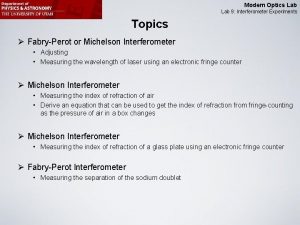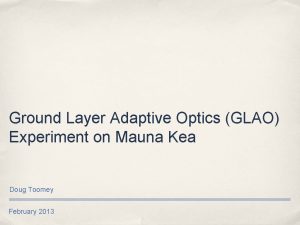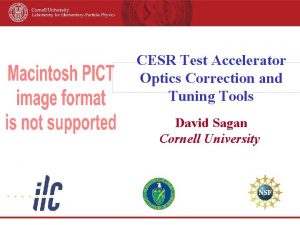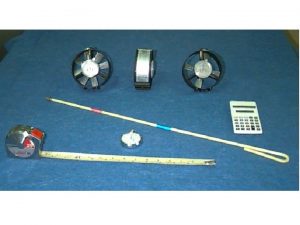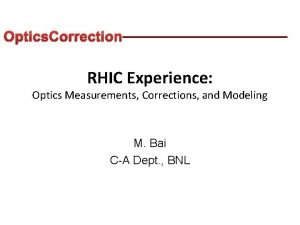Optics Correction at Cesr TA David Sagan Cornell













- Slides: 13

Optics Correction at Cesr. TA David Sagan Cornell University

Outline • Coupling Nomenclature • Betatron Phase & Coupling Measurement • Phase / Coupling Correction - Example • • July 10, 2008 Locating Phase & Coupling Errors AC Dispersion Measurement ORM Measurements Conclusion ILCDR 2008 - Cornell 2

Characterizing the Coupling Similarity Transformation of 1 -Turn 4 x 4 matrix transforming (x, px, y, py): “a”-mode ( 1) “b”-mode C(s) = 0 <==> No coupling Normalize C to take out beta dependence: Relationship between C and emittance: Cij(s) ~ 1/√ 2 <==> Full coupling (round beam with b ~ a) July 10, 2008 ILCDR 2008 - Cornell 3

Betatron Phase & Coupling Measurement Coupling and betatron phase and are measured by shaking the beam at a betatron resonance and looking at the response at the BPMs. - Shake the beam simultaneously at both “a”-mode and “b”-mode resonance frequencies. - Sample the position at a BPM 32 k times. - To filter signal look at average of: (xn, yn) * ei an n = 1, …, 32 k (xn, yn) * ei bn - Measurement time: 40 sec. for 100 BPMs. - Resolution ~ 0. 1 o • Shaking gives much better signal to noise than pinging the beam and watching it decay. July 10, 2008 ILCDR 2008 - Cornell 4

Beam Motion at a BPM a-mode excitation: y y x x General case: beam motion is elliptical No coupling case y y x C 12 0, C 22 = 0 x C 12 = 0, C 22 0 • Betatron phase: a = phase of oscillation of the x-component. • C 12 & a are insensitive to BPM tilts and individual BPM button gain errors. Can cleanly measure. • C 22 is sensitive to BPM tilts and individual BPM button gain errors. Data generally not as clean. • xamp a is sensitive to BPM button gain errors. Data generally not as clean. b-mode excitation: • Betatron phase: b = phase of oscillation of the x-component • C 12 & b are insensitive to BPM tilts and individual BPM button gain errors. Can cleanly measure. • C 11 is sensitive to BPM tilts and individual BPM button gain errors. Data generally not as clean. • yamp b is sensitive to BPM button gain errors. Data generally not as clean. July 10, 2008 ILCDR 2008 - Cornell 5

Example Measurement • Since the C 11 and C 22 data generally is noisy, it is generally not used in correcting the phase or coupling. • Also the amplitude data is not used. July 10, 2008 ILCDR 2008 - Cornell 6

Phase / Coupling Correction Phase / coupling correction procedure: 1. Start with: a) Measured phase and/or coupling data b) A model lattice that describes the machine. 2. Vary the quadrupole and/or skew quadrupole strengths in the model until the phase and/or coupling values as calculated from the model matches the measured data. This is done by minimizing a Merit function: M = i. Wi (Datai, meas - Datai, model)2 + j. Wj (kj, meas - kj, model)2 a) The change in quadrupole strength for the correction is: a) dkj = kj, design - kj, model 1. Note: This procedure allows for normal and skew quadruple calibrations: 1. Data is taken before and after a given quadrupole is varied. 2. The corresponding quadrupole in the model is fit to the phase or coupling difference. July 10, 2008 ILCDR 2008 - Cornell 7

Example Correction • Time to measure data, calculate and load a correction: few minutes. • Typically it will take 2 to 3 corrections for the measurement to converge. Before: Measurement - Design After: Measurement - Design Horizontal Betatron Phase Vertical Betatron Phase Cbar 12 Coupling Parameter Detector # • / ~ Detector # ~ 1 o / ~ 1. 5% • C 12 ~ 0. 01 => b(coupling)/ a ~ 10 -4 => b(dispersion) will dominate in Cesr. TA July 10, 2008 ILCDR 2008 - Cornell 8

New BPM Electronics • With all BPMs instrumented with individual readout modules, coupling, betatron phase, and position measurements could be made in real time (~1 second). • Complete installation scheduled for Early 2009. BPM Readout Module Block Diagram July 10, 2008 ILCDR 2008 - Cornell 9

Locating Phase and Coupling Errors The phase and coupling data can be used to locate and calculate the strength of quadrupole and skew quadrupole errors. Example: A backleg winding for a steering coil accidentally located near the beam pipe caused a skew quadrupole field in the vicinity of the beam. Using the coupling data, the location of the winding was pinpointed to within ~1 meter. Location of coupler July 10, 2008 ILCDR 2008 - Cornell 10

“AC” Dispersion Measurement • Minimizing the vertical dispersion is critical to achieving low vertical emittance. • Dispersion is coupling of longitudinal and transverse motion. Therefore: Analogous to the transverse coupling measurement, we can measure the dispersion by 1. Driving synchrotron oscillations via modulation of the RF amplitude at synchrotron tune. 2. Measure the resulting vertical & horizontal oscillations at the BPMs. Advantages over DC dispersion measurement: 1. Faster (changing the RF frequency is a relatively slow process). 2. 1/f noise is greatest at DC. 3. AC measurement requires less of a perturbation of the beam. [See David Rubin’s Wednesday talk for more details. ] July 10, 2008 ILCDR 2008 - Cornell 11

ORM Measurements • Taking data for an orbit response matrix analysis involves taking difference orbits while varying the steerings. • Taking ORM data at Cesr. TA involves varying ~120 steerings and takes about 2 hours. • ORM is typically used to correct quadrupole strength errors but at Cesr. TA it does not make sense to use ORM for this purpose at Cesr. TA given our ability to make fast phase/coupling measurements. • Currently it is being explored whether ORM can be used to measure BPM tilts and/or gains which is important for accurate measurement of the vertical dispersion. [See Jim Shank’s talk next. ] July 10, 2008 ILCDR 2008 - Cornell 12

Conclusion • Software and hardware has been developed at Cesr. TA which permits the rapid measurement and correction of orbits, dispersion, betatron phase, and coupling. Combining measurement, analysis and correction loading capabilities in a single program greatly streamlines the process. • The ability to rapidly make corrections is essential for reaching the required low vertical emittance in Cesr. TA and almost certainly will be essential for the ILC dampling ring as well. • Software has been developed which can locate isolated steering, qudrupole, and skew quadrupole errors. • Software has been developed to calibrate steerings, quadrupoles, and skew quadrupoles. • Individually powered magnets provides great flexibility in designing optics and correcting phase/coupling errors. • Until now, data such as C 11 and C 22 has been ignored since acceptable corrections could be made without this data. With the current demand for lower vertical emittance, a reexamination is in process. July 10, 2008 ILCDR 2008 - Cornell 13
 Cesr application
Cesr application Reflection and refraction venn diagram
Reflection and refraction venn diagram Difference between ray optics and wave optics
Difference between ray optics and wave optics Sagan we are made of star stuff
Sagan we are made of star stuff Carl sagan lunar eclipse
Carl sagan lunar eclipse Mito filosofia
Mito filosofia Laneysagan
Laneysagan Carl sagan maconha
Carl sagan maconha Moglie di carl sagan cruciverba
Moglie di carl sagan cruciverba Modern optics experiment
Modern optics experiment Rainbow optics star spectroscope
Rainbow optics star spectroscope Adaptive optics
Adaptive optics 368x5
368x5 Bill nye light and optics
Bill nye light and optics









